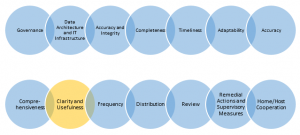 Principle 9:
Principle 9:
Risk management reports should communicate information in a clear and concise manner. Reports should be easy to understand yet comprehensive enough to facilitate informed decision-making. Reports should include meaningful information tailored to the needs of the recipients.
While the data management and data aggregation principles have been heavily emphasized in the financial press, the guidance dealing with reporting has not received as much attention. Clear and accurate reports must exist at all levels of the financial institution if risk is to be managed effectively. In this post, I will discuss the directive for clarity and usefulness in reporting. (Read the previous posts in this series.)
In December, 2013, the BCBS compiled a survey of large, global financial institutions to gauge how well they are positioned to comply with BCBS 239 by early 2016 (see Basel Committee on Banking Supervision, Progress in Adopting the Principles for Effective Risk Data Aggregation and Risk Reporting, December, 2013). The institutions assessed themselves on each of the principles, and the Committee then made comments on the results.
With regard to Principle 9, most institutions rated themselves fairly high. However, the Basel Committee noted several areas of regulatory concern. The Committee cited the following concerns:
- Lack of formalized inventory and documentation of reporting data marts.
- Lack of formal processes to recognize different needs of report users, including board members, CEOs and CFOs, at the group level.
- Lack of clear analytics or qualitative descriptions of trends and data challenges in risk reports
To address these issues, banks must enhance their reporting processes in parallel with their data aggregation initiatives. The enhanced data infrastructure should include a data mart in which final numbers for computed KPIs, KRIs and risk measures are stored. In addition, banks will need to tailor risk measures and KRIs to individual report users and ensure that these measures are available for any hierarchy within the bank.
Too often, a multitude of unreconciled risk reports exist throughout the bank. These reports often claim to analyze the same type of risk information, such as credit risk, but contain inconsistencies and, at times, present results in ways that are not targeted at the immediate user of the information. For example, a quantitative analyst and a board member may want to view an aggregated report on credit risk, but the ways in which they want the information presented will be very different. For the purposes of clarity and usefulness, trend reports delivered in a visual format are often the most effective for decision makers.
Read how SAS can help you meet the obligations of BCBS239. SAS solutions provide an end-to-end framework for addressing the principles of BCBS239 through data aggregation, visual risk reporting and useable risk measures.
